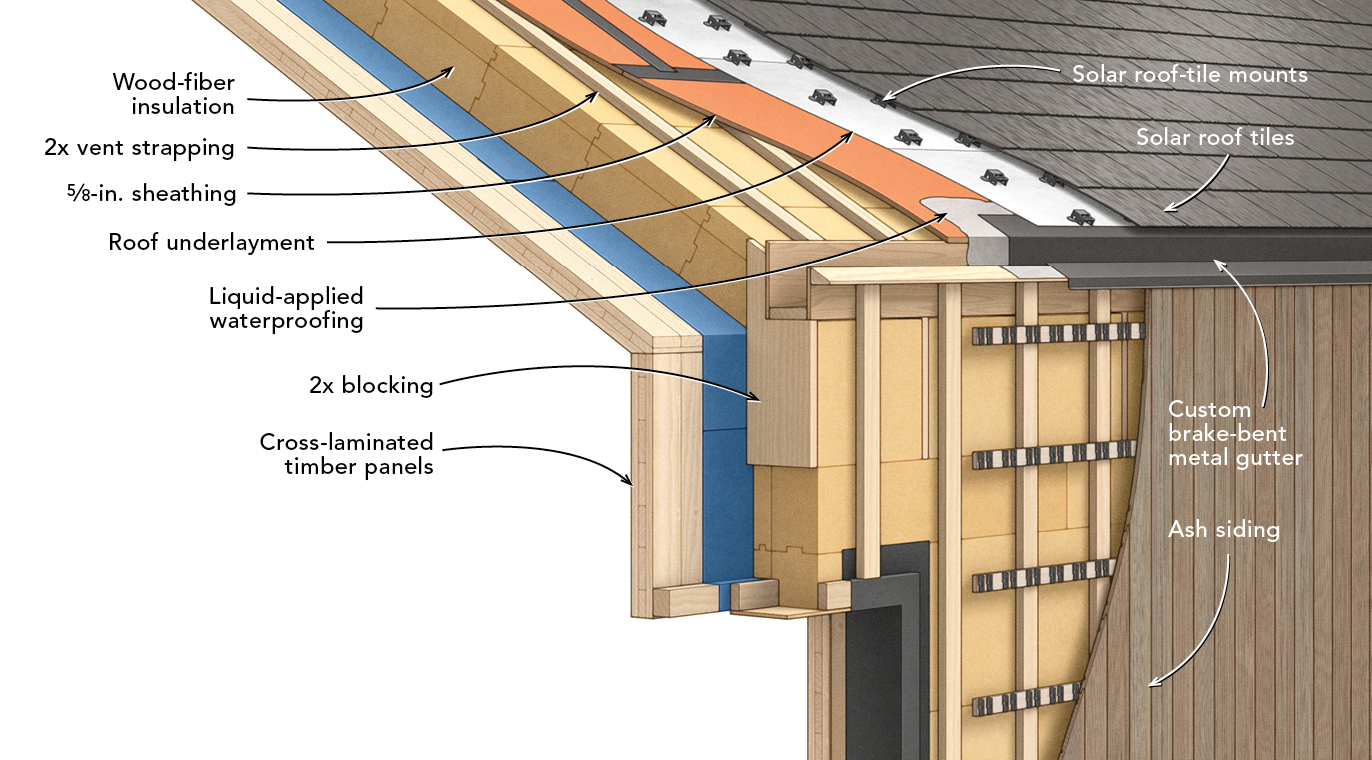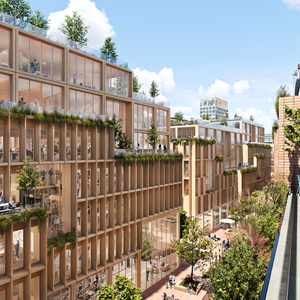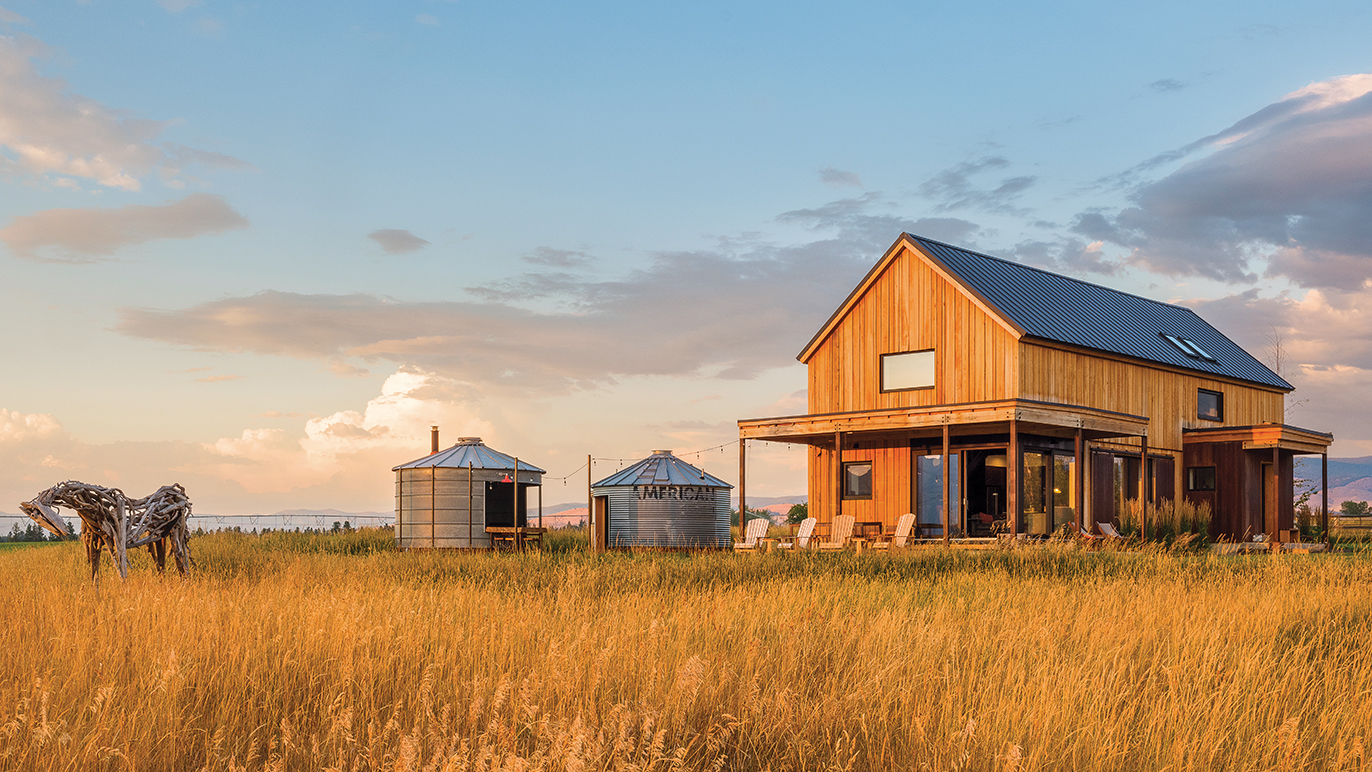
When it comes to mass timber, the bigger value proposition is still up for grabs. Many advocates celebrate the building material’s capacity for embodied carbon storage and sequestration, but that position arguably gets diluted as the scope and scale of what we’re building grows at exponential rates. And for an industry predicated on building accountability into the supply chain, going big only makes that mandate harder to maintain.
Another take is that mass timber’s greater value proposition lies in creating regional supply chains, from sourcing and milling to manufacturing and construction. Soup to nuts, on a local scale. According to Kyle Hanson, CEO of Timber Age Systems, in Durango, Colorado, “We can’t afford for it not to be local.”
Hanson’s company is located in Southwest Colorado, on the edge of San Juan National Forest, where Ponderosa Pine and other fast-growing species are in great abundance and, according to the U.S. Forest Service, in need of some serious thinning to mitigate the risks of wildfires. Thinning and long-term forest maintenance promotes biodiversity, contributes to healthy microenvironments, and early seedling establishment. Prescribed burning is one time-tested method for this, but the Federal Government has neither the budget nor personnel to handle all that dense, forested acreage that spans the continental divides. Plus, what a waste!
Enter cross-laminated timber
Timber Age Systems, which Hanson founded in 2018, creates cross-laminated timber (CLT) panels from Ponderosa pine lumber that is sourced entirely from wildfire-prone forests in the Durango area. The timber gets milled and manufactured in their facility in Ignacio, just 24 miles down the road, and is assembled into modular homes that Timber Age designs to Passive House specifications. Recently, the company was awarded up to $680,000 in grants from the Colorado Office of Economic Development and International Trade (OEDIT) for the construction of affordable housing units. Depending on the region and market conditions, Timber Age estimates that “a 1000-square-foot entry-level home could start as low as $300,000,” according to OEDIT’s October 24 press release. This is part of the state’s Innovative Housing Incentive Program, which Governor Polis’s office established to address Colorado’s housing shortage. Eligible manufacturers can receive up to $6000 for every unit manufactured and installed in the state.
By some accounts, Colorado is ground zero (or at least, one of several ground zeros) for the country’s affordable housing crisis. In an eye-opening 2022 piece in The New York Times, Denver was highlighted as just one fast-growing market in which the so-called “starter home” had become a relic of another time. “The nation has a deepening shortage of housing,” wrote that article’s author, Emily Badger. “But, more specifically, there isn’t enough of this housing: small, no-frills homes that would give a family new to the country or a young couple with student debt a foothold to build equity.”
Affordable housing meets CLT solution
For Hanson, the issues of affordable housing and forest management are intertwined. And cross-laminated timber, while not an incidental choice, just happens to be the vehicle that allows Timber Age to make the larger value proposition work. “We’re making CLT not because we just want to make CLT. It’s because we want to have watershed health and fire-resistance in our forests that are around the communities we’re working in.”
As for the issue of scalability, Hanson says that “all the variables keep moving,” but one area where that isn’t the case is transportation. “Our biggest cost is moving the wood. We’ve gotten to a point in the United States, especially in the intermountain West and obviously in a lot of California, where it’s more expensive to remediate after a fire than it is to augment the removal of [wood] fiber from the forest.”
The solution, it would appear, is to keep everything local, within reason. (Timber Age Systems will soon ship modular parts for a single home to New York State, at a cost of $7,000, though they stress this example is an outlier.) “We’re not competing with SmartLam,” Hanson says. “We’re operating in different markets. What we’re trying to affect is what happens in a community. And staying local helps with that side of it. It makes everything more personal.”
The timing of the OEDIT grant certainly works in Timber Age’s favor. As of this year, it is now producing CLT panels in tandem with insulated enclosure systems, resulting a vertically integrated operation that can provide all critical housing components in a single package. “From forest to frame,” says Chris Hamm, Timber Age’s VP of building systems and engineering. “We’re making the CLT and putting it into a fully insulated, panelized building system, all in one.” The company also has an active contract with the U.S. Forest Service to haul off felled lumber from sanctioned thinning efforts, which might otherwise get chopped up and kilned for firewood. “We want the wood to move. There’s plenty for everybody, if we can figure out the logistics.”
The logistics Hamm refers to are a matter of achieving equilibrium. Timber Age was established as a small, regional operation, and it has no intention of deviating course. When factories expand and production scales up, it can “run in contrast to what the forest needs,” Hanson says. “To make the numbers works, the amount of fiber you have to take out starts to put the consumer and producer at odds, and it’s the forest that is asked to sacrifice.” Indeed, sustainable growth on the part the company and good stewardship of the surrounding forestlands are not so much parallel efforts as they are joined at the hip.
With Timber Age’s first homes now in production, the immediate plan is to keep its entire operation to within a 100-mile radius—New York State notwithstanding—all while ensuring growth happens fast but remains local. And if or when its Ignacio-based production facility (a converted garage on a farm property), assembly plant (a partially covered carport), and sawmill collectively outgrow that radius, a new production line will go up.
Even with the OEDIT grants and partial funding from the Forest Service, the company remains very much in start-up status, and isn’t in any position to build a series of new, Passive House-ready, small single-family homes on spec. For the time being, Hanson, Hamm, and their colleagues are “chasing down sales” and looking to partner with architects, engineers, and building partners who have the capacity to absorb some of the upfront costs that come with scaling up.
Practically speaking, Timber Age Systems hasn’t found the solution to the housing crisis. But it has formulated a template for one. “We’re not trying to own every one of the pieces,” Hanson says, “but we are trying to influence and educate every chance we get.”
________________________________________________________________________
Justin R. Wolf is a Maine-based writer who covers green building trends and energy policy. Photo courtesy of Timber Age Systems.
Weekly Newsletter
Get building science and energy efficiency advice, plus special offers, in your inbox.















16 Comments
I expect there is a place for mass timber, and especially CLT panels in the building industry. But the recent spate of articles about it looks to me more like marketing than a reflection of real needs.
CLT panels are solid wood, several inches thick. I seriously doubt this is an efficient use of wood resources at least in a sector like single family homes, or up to 4-plexes. Prefabrication can and is as easily accomplished with standard frame construction and with SIPS. So CLT doesn't really offer any advantages because of prefabrication.
Wall panels of 2x6 framing at 24" on center, with an OSB face, can be prefabricated and shipped to the site quite easily. Insulated with r-20 cellulose batts, a smart membrane and finished with interior drywall, the job is done quickly, with a small fraction of the wood resources. This would work in most of the US climate zones. Some EPS on the exterior would help with the vapor control profile in the coldest climates. Rainscreen everything.
I'd like to see a detailed breakdown of the economic and environmental benefits of CLT panels over other prefabricated options such as I described above. I'm skeptical, at least at the level of single and small multi-family homes.
I think a more productive approach to reducing new construction housing costs would be to revisit the approach used by the manufactured (mobile) home industry. Raise the standards and quality of materials to something comparable with standard construction. But follow design principles used to achieve single and double wide designs that are somewhat modular and efficient to ship. Units could be shipped to the jobsite prewired, preplumbed, and to a large extent prefinished both inside and out. The work done in a warehouse setting would be free of weather constraints and theoretically could be done to an even higher standard of craftsmanship.
I would like to see a break down too. The caption for the picture raises my eyebrows:
"An example Timber Age Systems–fabricated CLT modular home; the Colorado company manufactures walls, floors and, roofs as prefabricated components designed to be lower cost than conventional framing/building methods. The 3-in.-thick CLT panels replace traditional studs, floor joists, and roof framing elements; and make for a ready surface for insulation and control layer membranes. "
I can't see how a solid 3" thick solid (effectively) wall doesn't use considerably more wood resources than regular framing (as you described). As for floors, does 3" CLT obviate the need for joists? If not I can't see it working out on a resource calculation there either. Maybe it works because the CLT methods are slightly more automated than building and shipping panels. Maybe.
I love the idea of CLT, but I'm not sure I believe it's cheaper than factory built stick framed panels.
I am also not convinced that CLT is an answer on a small scale, but your argument seems to assume that we have a shortage of trees available for lumber in North America. That's not really the case; from many perspectives we have more lumber than we can use efficiently, now that most paper manufacturing has moved overseas and insects and fungi are killing vast swaths of trees.
Where CLT makes environmental sense is to replace products with high levels of embodied carbon--i.e., anything with foam or Portland cement, typically taller buildings with different requirements than typical one- and two-family homes.
SIPs is never an environmentally responsible way to build; they have high levels of embodied carbon and they are extremely vulnerable to any mistakes in design or installation.
"your argument seems to assume that we have a shortage of trees"
If we have too much lumber then we need to stop cutting trees down. The best way to sequester carbon is not to cut the trees down in the first place. Leave them in place and let them mature to even more valuable sizes, while also providing habitat.
Although all foams and mineral wool have considerably higher levels of embodied carbon than cellulose insulation, not all foams are created equal. The HFO foams do considerably better than the HFC foams, which are mostly phased out. EPS still does better than mineral wool and all the other foams. A CLT wall has to be insulated just like any other. My hunch is the best option from a carbon perspective is 2x framing @ 24" oc with cellulose insulation. This would certainly outperform a CLT panel which would need some kind of additional structure to support batt or blown insulation. Otherwise we move to foam panels directly connected to the CLT.
There are a lot of permutations to consider. But I doubt any of them would outperform 2x framing with cellulose.
Properly detailed, SIPS can certainly provide a reliable, durable assembly. Improperly detailed they won't, especially in the coldest climates. Care in craftsmanship matters. In the case of SIPS it comes down to effective air sealing, which mostly amounts to a lot of tape. A lot was learned from the failures, especially those in Alaska. The most reputable manufacturers, such as Extreme Panel and Insulspan offer excellent detailing packages. Builders have to know what they're doing and have a good plan. But that's really no different than with any other system. The advantage of SIPS is that they lend themselves to modular and pre-fabricated designs and the infrastructure for them is already in place. But I still expect that a good 2x wall with cellulose insulation will beat SIPS with respect to embodied carbon.
The focus of the article was on providing affordable housing at the single family level by trying to reduce construction costs. In cities and close in suburbs, where land costs are high, you can only save so much through labor efficiencies. In the end the solution to affordable single family housing is probably to focus on rural development and the creation of more job opportunities outside the urban areas. Give people the chance to make a living where land is cheaper and that will reduce the demand in urban areas, reducing prices (much to the dismay of investors).
I'm not touching the issue of multi-family higher densities being part of the solution. Otherwise I'd end up writing a book here and this comment is already much too long.
Sure, leave the trees, don't touch the forests. Then prepare for unmitigated wildfires (even more than we have now), even more rampant pest damage, monocultures resulting from some species (hemlock, on my land) taking over and preventing other things from growing; landowners who can't afford to pay taxes on multi-thousand-acre parcels so they sell them for development (housing, mining). While I truly wish we could just leave the forests as wild places, the reality of things like capitalism and climate change make that not a realistic goal.
I don't think it's possible to improve on the efficiency of modern platform framing, in terms of quantity of material use or thermal performance when building low-rise homes. But material use and thermal performance are not the only metrics worth considering, and the metrics change as buildings get larger and taller--the proportions of volume to perimeter, occupant loads, types and efficiencies of equipment--all change the equation.
I've personally fixed, and in my younger years, probably caused several failures of SIPs construction. I agree that they CAN be built well, but the reality is that they often are NOT built well. Unfortunately it typically takes 10+ years for issues to show up, and by then the builder is long gone and the problem is widespread enough to be a huge challenge to fix. I'm not talking in hypotheticals, these are things I have seen. Most recently I consulted on a SIPs home where the builder made many mistakes and it was too late to fix most of them without tearing off the recently completed drywall. And this was a builder supposedly familiar with SIPs.
HFO-blown foams are significantly better than HFC-blown foams. I have all of the EPDs and LCAs and have done my own math on each of them, as well as paid close attention to others doing analyses such as the BEAM tool. There is still a big difference between foam and mineral wool compared to cellulose or wood fiber. A rough approximation is that fully spray-foaming a 2500 sq.ft. house is equivalent to driving an average (25mpg) car 25,000 miles. That may not seem like a lot to you, and I use foam when nothing else will reasonably work, but using it where it's not necessary--such as in SIPs--and then saying we shouldn't touch the trees in the forests is a specious argument at best.
Michael,
Many commenters (myself included, occasionally) use their own local experience to generalize about forests. Here in Vermont, where I live, the forest fire risk is very close to zero -- although that may change, as we all know. I have personal experience with Vermont forests allowed to develop without human intervention, and based on my observation and knowledge of forestry, the forests are doing fine. All that may change, of course, when climate change kills the balsam firs and allow the invasion of oaks -- but it's simply untrue that northern forests in Vermont need to be thinned to avoid the type of forest fire risk that Western foresters are familiar with.
Martin, hopefully it was obvious that not every one of my predictions would be true for every location. My apologies if that needed to be more clear.
I live on 30 acres of woodland and I'm surrounded by many square miles of forest, nearby in Maine. While Vermont has had copious rainfall in recent years, we have had many years of drought in the summer--every step in the woods is noisy from dry twigs and limbs on trees bend nearly to the ground, waiting for water. Forest fire danger has been high most of the time. It would not take much to have a disastrous wildfire; the woods are full of deadwood. The Wooly Adelgid beetle and the Emerald Ash borer are here and in the next few decades will kill most of our ash and hemlock trees; browntail moths have caused significant damage, especially to oaks and apples; other insect pests are already affecting our large population of red oaks and other trees.
I'm not saying that logging will fix any of those problems, but as the quantity of deadwood in the forests increases in coming decades and as climate change makes our summers much drier than they have been in the past, we may see the need for western-style forest management.
Michael,
I appreciate your perspective. And I'm sorry to hear about the situation in Maine. One thing's for sure: we're in for some changes in the decades ahead.
You are right. Timber Age specifically goes into fire zones to help clean them up. it is a sort of artisanal CLT made on site. Using more wood is a feature, not a bug.
Ok, so this starts to make more sense then. I wasn't particularly clear, but I was wondering how a CLT panel would be less expensive than a factory made stick built panel. That they're focusing on *local* means they're taking into account what you need to make any panelized system cost effective (from what I've read elsewhere, I claim no special expertise). The shipping can't be crazy, you need a crew that can handle it, and crane rental has to be priced right.
The other part Tim_Williams brings up in #11. If CLT can use wood not appropriate for standard framing, they may be able to reduce the cost of the panel enough to make it cheaper than a standard framing panelized system.
A good solution to multiple problems under the right circumstances, but not universally applicable. So maybe I'll have a CLT house someday after all.
I understood it like that: what do you do if you have wood and don't want to burn it (and have no other use)?
A CLT will use more wood than a plattform framed structure, so in a sense it is more efficient to use up the wood in such a way and trap the CO2.
That is "ok" in my book if all the houses needed in that area are actually built (all the houses people can pay for..)
wastl,
Wouldn't that have to be evaluated against other sequestration strategies to see how much energy it used? I'd be surprised if using as much manufactured wood products as you can fit into a house just to keep them from emitting carbon yields results that make any significant dent in the problem.
Too much lumber and don't want to burn it?
How about not cutting the trees down in the first place?
Basically someone made a mistake. CLTs may be a way to deal with that mistake but then let's not go on and repeat the mistake. Let's cut down only what we need and leave the rest standing.
The idea of just leaving the trees standing is not workable in parts of the country due to the build up over time of dense forests. We have a property in central Colorado where there has been no forestry or fires for over 100 years. the density of the forests is such that if a fire broke out the temperature would be so high as to sterilize the soil, kill and seeds or seedlings and result in hillsides of of lifeless mineral soil. This would take 100's or ore years to regenerate. This happened nat far away 30 or so years ago and the ground is still totally lifeless. Additionally, our valleys ultimately flow into the Denver water supply so letting the streams get silty or clogged after a fire will result in problems downstream.
We can either accept the risk or engage in some active measures to thin the forest. There is no real local market for the thinned trees which drives the cost to 2500/3000 acre for relatively level and accessible areas, and 5000/ 6000 acre for steep slopes as there is no offset from selling the trees. We have, with neighbors, close to 4000 acres. The least cost solution is to excavate a giant pit, chip and bury all the slash, and then hope to find someone to pay to take the trunks away. That or pit burners.
If there was a market to use the trees that would be an enormous help, and there are lots of parts of the state, and west in general, in this situation.
We can certainly debate the wisdom of past actions to let the forests get so thick, but it is done, and they need to be addressed somehow. If they were to burn the carbon would all be released.
The option to just let them grow will not work in this case.
From what I understand, CLT can use lumber that is otherwise worthless for building, so having 10x the wood mass in a wall isn't really an issue. I could see a CLT manufacturer in Maine team up with TimberHP for insulation and Mathews windows for a mostly locally sourced house.
If you are strictly calculating carbon, I guess the question is how much energy goes in to the CLT process vs stick framing and sheathing or other alternatives..
If you think CLT is great, check out the new hot tech: SIT, Spaced Insulated Timber, where you use less wood, and the space between the timbers is filled with wood fiberboard, hemp, wool, or cellulose. It can be prefabricated, doesn't need engineering (beyond code prescriptive), is understood by builders and inspectors, and is a low- or negative-carbon structural system! Oh wait, that isn't new is it? Seriously, there are some things CLT is great for (midrise in Chicago), but slabs of wood are not what's needed to solve small-scale housing needs. And CLT introduces the problem of how to insulate the slabs: great if you use wood fiberboard, but you'll need 6-8+ inches in climate zones 5 and up, and if you go to mineral wool or foam, you're undoing the upfront carbon benefit of the structure. Instead, put a bunch in the SIT stud cavities, put a bit of wood fiberboard on the outside or double-stud, and change the focus to good design and delivery systems to get quality to the people. SIT is the S*IT!
Log in or create an account to post a comment.
Sign up Log in